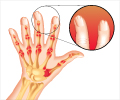Just one hour of weekly brisk walking can ward off disability in older adults with osteoarthritis, reveals a new study.

‘Just one hour of weekly walking can ward off disability in older adults with arthritis pain.’
Read More..




"This is less than 10 minutes a day for people to maintain their independence. It’s very doable," said lead author Dorothy Dunlop, professor of preventive medicine at Northwestern University Feinberg School of Medicine. "This minimum threshold may motivate inactive older adults to begin their path toward a physically active lifestyle with the wide range of health benefits promoted by physical activity."Read More..
An estimated 14 million older adults in the U.S. have symptomatic knee osteoarthritis, which is the most common form of osteoarthritis. Approximately two in five people with osteoarthritis -- most of whom have it in their lower joints -- develop disability limitations.
The study found an hour of weekly moderate-to-vigorous physical activity allowed older adults to maintain their ability to perform daily tasks like getting dressed or cross a street before a traffic light walk signal changed.
The weekly hour of exercise reduced their risk of mobility disability (walking too slowly to safely cross a street or less than one meter per second) by 85 percent and their risk of activities of daily living disability (difficulty performing morning routine tasks such as walking across a room, bathing and dressing) by almost 45 percent.
Four years after the start of the study, 24 percent of adults who did not get the weekly hour of brisk physical activity were walking too slowly to safely cross the street, and 23 percent reported problems performing their morning routine.
Advertisement
"Our goal was to see what kind of activity would help people remain free of disability," Dunlop said.
Advertisement
But that level of activity can be daunting for inactive older adults with lower extremity pain, Dunlop said.
"We hope this new public health finding will motivate an intermediate physical activity goal," Dunlop said. "One hour a week is a stepping stone for people who are currently inactive. People can start to work toward that."
Source-Eurekalert















